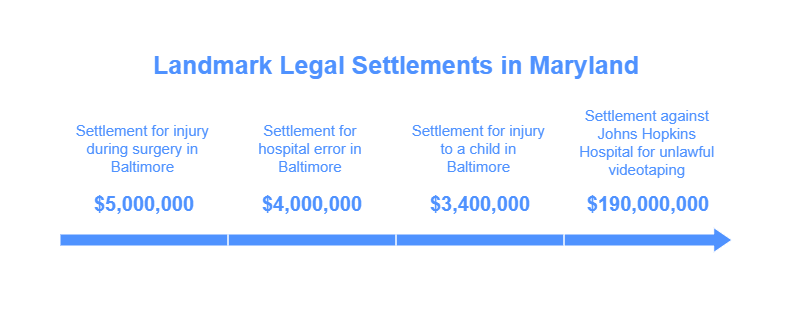
Maryland’s cap on non-economic damages for 2025 stands at $950,000 for personal injury and wrongful death cases with one beneficiary, increasing annually by $15,000 each October 1st.
If you or a loved one has suffered serious injuries or lost a family member due to someone else’s negligence, this statutory cap could significantly limit your pain and suffering compensation, even if a jury awards you more.
The financial impact of this limitation can be devastating for families already facing overwhelming medical expenses, lost income, and the emotional trauma of dealing with catastrophic injuries or the death of a loved one.
I have 30 years of experience helping people go through these complex legal challenges and understand exactly how Maryland’s damage caps affect your case. When you call, you will speak directly with Frank. Our proven track record includes substantial settlements that demonstrate our commitment to securing maximum compensation within Maryland’s legal framework:
- $5,000,000: Awarded a $5 million settlement for injury during surgery in Baltimore.
- $4,000,000: Awarded a $4 million settlement for hospital error in Baltimore.
- $3,400,000: Awarded a $3.4 million settlement for injury to a child in Baltimore.
- $190,000,000: Awarded $190,000,000 against Johns Hopkins Hospital on behalf of former patients of Dr. Nikita Levy for unlawful videotaping.
Our Maryland medical malpractice lawyer will ensure you understand how the cap affects your case and work tirelessly to maximize your recovery.

Maryland’s Cap on Non-Economic Damages in Detail
Maryland implemented its cap on non-economic damages to limit the amount plaintiffs can recover for pain and suffering, with the current limit set at $950,000 for most personal injury cases as of 2025. The Maryland cap was introduced to provide predictability in civil litigation and help control insurance costs for defendants and healthcare providers.
However, this system has drawn criticism from victim advocates who argue it unfairly penalizes those with the most severe injuries.
The cap increases every year on October 1st to account for inflation and economic changes. Importantly, the applicable cap amount is determined by when the injury or death occurred, not when the lawsuit is filed. This means if your injury happened in 2022, you would be subject to the lower cap amount that was in effect during that year.
⚖️ Knowing how to prove medical malpractice becomes essential when dealing with cases subject to lower caps, as the strength of your evidence directly impacts whether you receive the full amount available. The medical malpractice statute of limitations in Maryland also plays a critical role, as timing determines which year’s cap applies to your case.
Even cases involving suing for nerve damage from IV must consider how the Maryland cap on non-economic damages affects potential recovery. For 2025, the medical malpractice cap stands at $905,000, while general personal injury cases allow up to $950,000 in non-economic damages.
The Maryland General Assembly provides detailed information about how these caps are applied in different types of cases, ensuring transparency in the judicial process for all parties involved.
Understanding Non-Economic Damages
Non-economic damages represent compensation for losses that cannot be easily quantified with receipts or invoices. These damages are subjective and aim to compensate victims for intangible suffering caused by another party’s negligence. Unlike economic damages such as medical expenses and lost wages, pain and suffering damages require careful evaluation of how an injury impacts a person’s quality of life.
Common types of non-economic damages include physical pain and suffering, emotional distress, mental anguish, loss of enjoyment of life, disfigurement, disability, and loss of consortium. In wrongful death cases, these damages extend to the grief, sorrow, and loss of companionship experienced by surviving family members.
Hypothetical Scenario: A patient suffers a spinal cord injury during a botched surgical procedure. While his medical bills and lost wages (economic damages) can be calculated precisely, the jury must assess his ongoing physical pain, emotional trauma from becoming paralyzed, and loss of ability to enjoy activities he once loved (non-economic damages).
The challenge with grasping non-economic damages lies in their subjective nature. What constitutes adequate compensation for chronic pain varies significantly from person to person. This subjectivity is precisely why Maryland and many other states have implemented caps to provide some level of predictability in jury awards.
Current Cap Amounts and Annual Increases
Maryland’s damage caps vary depending on the type of case and number of claimants involved. The system includes several different calculations to account for various scenarios:
- General Civil Cases (One Beneficiary): $950,000 for injuries occurring in 2025, with the cap increasing by $15,000 annually
- Wrongful Death Cases (Multiple Beneficiaries): Up to 150% of the base cap, reaching $1,425,000 when two or more wrongful death beneficiaries are involved
- Medical Malpractice Cases: Separate cap structure with $905,000 for individual cases in 2025
- Combined Wrongful Death and Survival Actions: Maximum of $2,375,000 when both claims are filed together
The annual increase mechanism ensures the caps keep pace with inflation and economic changes. These cap increases occur every October 1st, providing predictable adjustments that courts and attorneys can rely upon when calculating potential recoveries.
📌 The timing of when your cause of action arose determines which year’s cap applies to your case, not when you file the lawsuit. This distinction can mean thousands of dollars in difference depending on when your injury occurred versus when legal action begins.
Application of the Cap in Different Scenarios
Multiple Claimant Situations
When wrongful death lawsuits involve multiple beneficiaries, Maryland law allows for enhanced recovery beyond the standard cap. If there are two or more wrongful death beneficiaries, the maximum compensation increases to 150% of the base cap, regardless of how many family members are involved.
This means a spouse and one child receive the same 50% increase as a spouse with several children.
Wrongful Death and Survival Action Combinations
Maryland distinguishes between wrongful death claims brought by surviving family members and survival action claims brought by the deceased person’s estate. Each type of claim has its cap, but when both are filed together, the combined maximum recovery for non-economic damages can reach substantial amounts.
The survival action allows the estate to recover for the pain and suffering the deceased experienced before death.
Court Application After Jury Verdicts
Hypothetical Scenario: A jury awards $1.2 million in pain and suffering damages to a plaintiff who suffered permanent brain damage in a car accident. Because this exceeds Maryland’s $950,000 cap for non-medical malpractice cases, the court must reduce the award to comply with the statutory limitation, despite the jury’s determination that the higher amount was appropriate.
Jurors are not informed about damage caps during trial proceedings. They deliberate and reach verdicts based solely on the evidence presented, allowing them to make unbiased assessments of appropriate compensation. Only after the verdict does the court apply any applicable caps to reduce awards that exceed statutory limits.
I am here to listen to you and assist you in managing the legal system. Our Baltimore medical malpractice lawyer understands these complex application scenarios and will ensure your case is properly positioned to maximize recovery within legal limits.
Maryland Medical Malpractice Cap: Special Considerations
The cap for medical malpractice cases in Maryland operates under different rules and amounts compared to general personal injury claims. These distinctions reflect legislative policy decisions about healthcare liability and insurance costs:
- Lower Base Amount: Medical malpractice caps are typically $45,000 lower than general injury caps for the same year
- Separate Annual Increases: Malpractice caps increase by $15,000 annually but follow their own timeline and calculation method
- Different Effective Dates: The medical malpractice cap system was implemented with its own start date and progression schedule
- Aggregate Application: All claims arising from the same medical incident share a single cap amount, regardless of how many patients or family members are involved
💡 Recent legislative proposals have sought to significantly increase the general non-economic damages cap to $1,750,000, though these changes would not affect medical malpractice cases, which would continue operating under their separate cap structure.
The Johns Hopkins University School of Medicine conducts research on patient safety and medical error prevention that informs policy discussions about malpractice liability and damage caps. Getting to know these research findings can be valuable for both patients and healthcare providers managing the medical malpractice landscape.
| Case Type | Cap Amount | Multiple Claimants | Annual Increase |
|---|---|---|---|
| General Personal Injury | $950,000 | N/A | $15,000 |
| Wrongful Death (One Beneficiary) | $950,000 | N/A | $15,000 |
| Wrongful Death (Multiple Beneficiaries) | $1,425,000 | 150% of base | $22,500 |
| Medical Malpractice | $905,000 | The same cap applies | $15,000 |
| Combined Death/Survival | $2,375,000 | Complex calculation | Variable |
Impact of Caps on Plaintiffs and Defendants
Damage caps create a tension between providing adequate compensation to victims and maintaining predictable liability exposure for defendants and insurance companies.
For plaintiffs, caps can mean receiving significantly less than what a jury determined was fair compensation for their suffering. This limitation particularly affects those with the most severe, life-altering injuries who may receive the same capped amount as someone with less serious injuries.
From a defendant’s perspective, caps provide certainty in litigation strategy and insurance planning. Healthcare providers and other potential defendants can better predict their maximum exposure in non-economic damages, which helps with insurance coverage decisions and risk management strategies. Insurance companies often cite caps as essential for keeping premium costs manageable for policyholders.
The debate over caps reflects broader questions about tort reform and access to justice. Supporters argue caps prevent runaway jury awards and help keep essential services affordable. Critics contend that caps deny full compensation to those who need it most and remove important incentives for safety improvements by limiting consequences for negligent behavior.

Exceptions and Special Cases
While Maryland’s caps apply broadly to non-economic damages in personal injury and wrongful death cases, several important exceptions and special considerations exist:
- Economic Damages Unlimited: No caps apply to quantifiable losses like medical bills, lost wages, or future medical expenses, allowing full recovery of actual financial harm
- Punitive Damages Exempt: When punitive damages are available under Maryland law, they are not subject to the non-economic damage caps
- Federal Cases: Cases filed in federal court may involve different damage cap applications depending on the specific claims and applicable law
- Workers’ Compensation: Workplace injury cases typically follow separate compensation schemes that don’t involve traditional damage caps
⚠️ Accepting a settlement offer early in your case could prevent you from receiving the full amount available under the cap if additional damages become apparent later. Insurance companies often make initial offers well below cap amounts, hoping to resolve cases before the full extent of injuries becomes clear.
Special circumstances may arise in cases involving multiple defendants, comparative negligence, or complex liability scenarios. Each situation requires careful analysis to determine how caps apply and what recovery options exist for maximizing compensation within legal limits.
The Future of Non-Economic Damage Caps in Maryland
Recent legislative proposals, including House Bill 113 and Senate Bill 538, have proposed significant changes to Maryland’s damage cap system, with some seeking to eliminate caps or raise them substantially to $1.75 million.
These proposals face strong opposition from business groups and insurance companies, who argue that removing or dramatically increasing caps would lead to higher insurance premiums and potentially drive some businesses out of Maryland.
Proponents of cap reform argue that the current limits, established decades ago, no longer provide adequate compensation for severe injuries when adjusted for inflation and increased medical costs. They point to cases where victims with catastrophic injuries like brain damage receive the same capped amount as those with lesser injuries that fully heal.
The outcome of these legislative debates will significantly impact future personal injury litigation in Maryland. Changes to the cap system could affect settlement negotiations, trial strategies, and insurance coverage decisions across multiple industries. Legal professionals and advocacy groups continue monitoring these developments closely.
National trends in tort reform and damage caps vary significantly by state, with some jurisdictions moving toward higher caps or elimination while others maintain or strengthen existing limitations. Maryland’s approach will likely continue evolving as lawmakers balance the competing interests of victim compensation and economic predictability.
If you have been injured in Washington, DC, our DC medical malpractice lawyer will help you understand how different jurisdictions’ laws might affect your case and potential recovery options.
Final Thoughts
Maryland’s cap on non-economic damages significantly impacts personal injury and wrongful death cases by limiting pain and suffering compensation to $950,000 for most cases in 2025. Knowing how these caps apply to your specific situation is essential for making informed decisions about legal action and settlement negotiations.
The complex interaction between different cap amounts, multiple claimant scenarios, and timing considerations requires experienced legal analysis to maximize your potential recovery.
While damage caps limit non-economic damages, they do not affect economic damages like medical expenses and lost wages, which remain fully recoverable. The distinction between different types of cases—medical malpractice versus general negligence—also creates important strategic considerations that can impact the total compensation available.
Please call me toll-free at 443-845-1456 for a free consultation. When you call, you will speak to Frank personally, or contact us today to discuss how Maryland’s damage caps affect your case and learn about your options for maximum recovery.

FAQs
What types of injuries or cases are exempt from the non-economic damages cap in Maryland?
No personal injury cases are completely exempt from Maryland's cap on non-economic damages, but the caps don't apply to economic damages or punitive damages when available. Cases involving intentional torts may have different damage structures, and federal cases might involve different cap applications.
Workers' compensation cases follow separate statutory schemes that don't typically involve traditional damage caps. The key distinction is between different types of damages rather than exempt injury types—your medical expenses and lost income remain fully recoverable regardless of the non-economic damage limitations.
Can I challenge the constitutionality of Maryland's damage caps in my case?
While Maryland's damage caps have faced constitutional challenges over the years, courts have generally upheld them as valid legislative policy decisions.
Individual plaintiffs rarely succeed in constitutional challenges to the cap system, as these typically require broader legal arguments about due process or equal protection that courts address at the systemic level.
Our attorney will focus on maximizing recovery within the existing legal framework rather than challenging the caps themselves. However, ongoing legislative efforts continue seeking to modify or eliminate the caps through the political process.
How do Maryland's damage caps compare to those in neighboring states?
Maryland is one of only nine states that cap non-economic damages in personal injury cases, with neighboring Virginia and West Virginia also having medical malpractice caps but different approaches to general injury cases.
Pennsylvania and Delaware have no caps on non-economic damages for personal injury cases, while Virginia caps medical malpractice damages but not general injury cases. Each state's approach reflects different policy decisions about balancing victim compensation with liability predictability.
How can an experienced attorney help maximize my compensation within the limits of Maryland's damage caps?
Our experienced Maryland personal injury lawyer will thoroughly document all economic damages to ensure full recovery of medical expenses, lost wages, and future costs, which aren't subject to caps. I will also work to maximize non-economic damages up to the cap limit by presenting compelling evidence of pain, suffering, and life impact.
Strategic decisions about case timing, defendant selection, and claim structure can affect the applicable cap amount and total recovery potential.
My 30 years of experience and knowledge of how caps apply in different scenarios—including wrongful death cases with multiple beneficiaries—ensure your case is positioned for maximum compensation within Maryland's legal framework.
